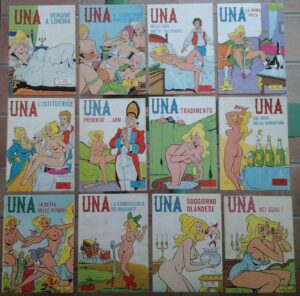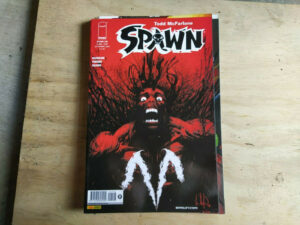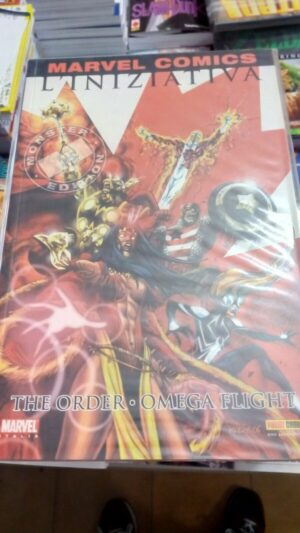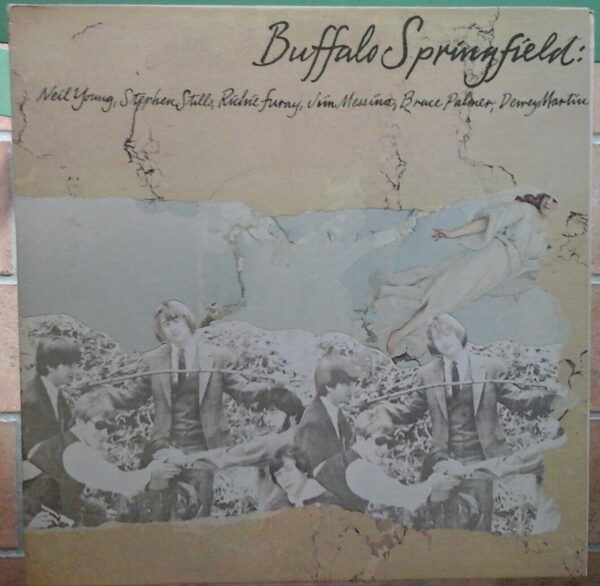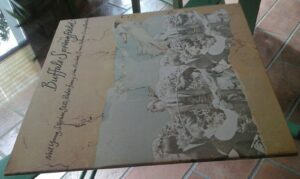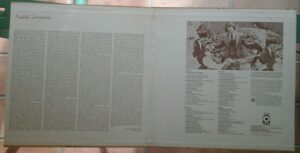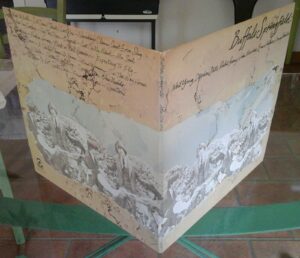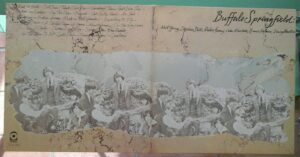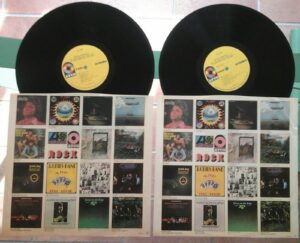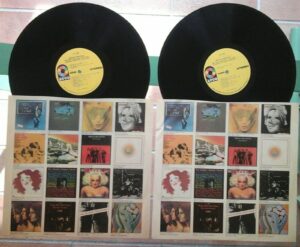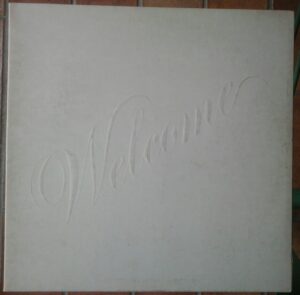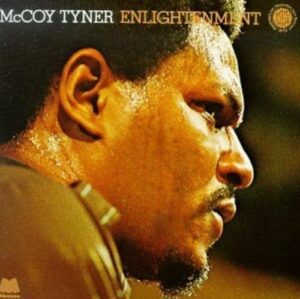Description
BUFFALO SPRINGFIELD
NEIL YOUNG, STHEPHEN STILLS, RICHIE FURAY, JIM MESSINA, BRUCE PALMER, DEWEY MARTIN
collection
Disco Doppio 2 LP 33 giri , 1973, Atco , SD2-806 , 0698 , USA
ECCELLENTI CONDIZIONI, vinyl ex++/NM , cover ex++/NM
I Buffalo Springfield furono un gruppo di folk–rock statunitense degli anni ’60 proveniente da Los Angeles formato da Neil Young, Stephen Stills, Richie Furay (poi Jim Messina), Bruce Palmer, Dewey Martin.
Il gruppo ebbe vita breve: formatosi nel 1966, si sciolse due anni più
tardi, nel 1968. I disaccordi personali fra Stills e Young, forti
personalità musicali, furono probabilmente all’origine della precoce
fine della band. Curiosamente Stills e Young si troveranno ancora a
suonare insieme, e ad elaborare nel contempo strane e incomprensibili formule algebrico-alchemiche, ad iniziare dal CSN&Y, costituitosi un paio d’anni più tardi, e sottoposto negli anni a elaborazioni di calcolo estremamente complesse, che per i profani delle scienze matematiche si possono riassumere e semplificare scomponendole nei passaggi più elementari, dapprima CSN&Y – Y = .CSN , CSN – S = CN , CN % 2 = C e N , CN + (S&Y) = CSN&Y bis, √ ²CSN = Y ²
Buffalo Springfield was a short-lived folk rock group that served as a springboard for the careers of Neil Young, Stephen Stills, Richie Furay and Jim Messina and is best known for the song “For What It’s Worth“. After the band’s formation in April 1966, a series of disruptions, including infighting and the pressure of working in the music industry,
resulted in constant changes in the group’s lineup and ultimately
culminated in the group’s disbanding after roughly 25 months. Buffalo
Springfield released a total of three albums but left many demo recordings, studio outtakes and live recordings, as well as a reputation for excellent personnel and high band dysfunction.
Buffalo Springfield (collection) is a compilation album released as a double LP in 1973 by Buffalo Springfield. It features a 9 minute version of “Bluebird” unavailable elsewhere.
Compilation del 1973, doppio album con 23 brani del periodo 1966-68, una formazione da brivido zeppa di nomi eccellenti che eseguono divinamente storici pezzi da delirio, tra cui “Bluebird” nella leggendaria long version di 9 minuti, brano tra l’ altro pubblicato solo su vinile e MAI ristampato su CD (ovviamente lo potete trovare in rete su youtube, ma non è la stessa cosa che ascoltarsi il disco in un impianto come si deve, ve lo assicuro). Da non confondersi pertanto con l’ eponimo del 1966, leggere attentamente le avvertenze e le precauzioni d’uso, maneggiare con cura, non somministrare a bambini e donne in gravidanza, l’ abuso può dare luogo a fenomeni di sensibilizzazione o di dipendenza, ogni riferimento a fatti e persone è puramente casuale, consultare il medico prima di ingoiarlo o di conficcarselo nel retto.
- Interprete: Buffalo Springfield
- Etichetta: Atco / Atlantic
- Catalogo: SD 2 – 806
- Data di pubblicazione: 1973
- Matrici : ST – C – 732873 – B AT PR / ST – C – 732874 – D AT PR / ST – C – 732875 – A AT PR / ST – C – 732876 – A AT PR
- Supporto:vinile 33 giri
- Tipo audio: stereo
- Dimensioni: 30 cm.
- Facciate: 4
- Gatefold textured cover / copertina apribile in cartoncino tessutato , yellow label , Atlantic-Atco catalogue inner sleeves
Not to be confused with their self-titled debut album, this double LP,
which can still be found without too much hassle, is clearly the best
Springfield compilation, at least until the overdue day when a box set
appears that includes everything recorded by this superb band. It does
miss some good songs, especially from the first album, but zeroes in on
their very best work, and includes a nine-minute version of “Bluebird”
available nowhere else, as well as excellent liner notes.
Track listingSide one
Side two
Side three
Side four
|
Line Up:
- Ahmet Ertegun – Producer
- Richie Furay – Guitar (Rhythm), Vocals, Producer
- Charles Greene – Producer
- Dewey Martin – Drums
- Jim Messina – Bass, Producer
- Jack Nitzsche – Producer
- Bruce Palmer – Bass
- Stephen Stills – Guitar, Vocals, Producer
- Brian Stone – Producer
- Neil Young – Guitar, Vocals, Producer
History
Origins
Neil Young and Stephen Stills first crossed paths at a folk club in Thunder Bay, Ontario. Young was there with The Squires, a Winnipeg group he had been leading since February 1963, and Stills was on tour with The Company, a spin off from the Au Go Go Singers.
Although the two would not see each other again for almost a year, the
encounter left both with a strong desire to work together.
When The Company broke up at the end of that tour, Stills moved to the West Coast, where he worked as a studio musician and auditioned unsuccessfully for, among other things, The Monkees. Told by record producer Barry Friedman
that there would be work available if he could assemble a band, Stills
invited fellow Au Go Go Singers alumnus Richie Furay and former Squires
bass player Ken Koblun to come join him in California. Both agreed, although Koblun chose to leave before very long and rejoined the group 3’s a Crowd.
In early 1966 in Toronto, Young met Bruce Palmer, a Canadian who was playing bass for a group called the Mynah Birds.
In need of a lead guitarist, Palmer invited Young to join the group,
and Young accepted. The Mynah Birds were set to record an album for Motown Records when Rick James, their singer, was arrested for draft evasion. With their record deal canceled, Young and Palmer decided to head for Los Angeles where they hoped to hook up with Stills.
Roughly a week later, discouraged at having been unable to locate Stills and ready to depart for San Francisco, they were stuck in traffic on Sunset Boulevard
in Los Angeles when Stills, Furay and Friedman, sitting in their white
van, recognized Young’s black 1953 Pontiac hearse, which happened to be
passing by in the opposite direction. After an illegal u-turn by Furay,
some shouting, hand-waving, and much excitement, the four musicians
realized that they were united in their determination to put together a
band. Drummer Dewey Martin, who had played with country artists such as Patsy Cline and The Dillards, was added to the roster less than a week later after contacting the group at the suggestion of the Byrds‘ manager, Jim Dickson.
Taking their name from the side of a steamroller—made by the Buffalo-Springfield Roller Company—that
had been parked on the street outside Friedman’s house (where Stills
and Furay were staying), the new group debuted on April 11, 1966 at The Troubadour in Hollywood. A few days later, they began a short tour of California as the opening act on a bill featuring the Dillards and the Byrds.
Management and First Recordings
No sooner had the Byrds’ tour ended than Chris Hillman persuaded the owners of the Whisky a Go Go
to give the band an audition. Buffalo Springfield essentially became
the house band at the Whisky for seven weeks, from May 2 to June 18,
1966. This series of concerts solidified the band’s reputation for
exhilarating live performances and attracted interest from a number of
record labels. It also brought an invitation from Friedman to Dickie
Davis, who had been lighting manager for the Byrds, to become involved
in the group’s management. In turn, Davis sought advice from Sonny & Cher’s management team, Charlie Green and Brian Stone. They eventually struck a deal with Ahmet Ertegün of Atlantic Records and arranged for the band to start recording at Gold Star Studios in Hollywood.
Young, Stills and Furay would all record demos for the album, but Greene and Stone, who had installed themselves as the album’s producers, deemed Young’s voice “too weird” and assigned lead vocals on the majority of Young’s songs to Furay.
The first Buffalo Springfield single, “Nowadays Clancy Can’t Even
Sing”, was released in July but made little impact outside of Los
Angeles, where it reached the Top 25. The group was dissatisfied with
and reworked some of their early recording efforts for the rest of the
album. In fact, Young and Stills have long maintained that their own mono mix was superior to the stereo mix engineered by Greene and Stone. The album—eponymously titled Buffalo Springfield—was originally released by Atlantic’s subsidiary Atco
in mono and in stereo in October 1966. A revamped version (see below)
issued both in mono and stereo with a different track order, came in
March 1967.
In November 1966 Stills composed his landmark song, “For What It’s
Worth”, after witnessing police actions against the crowds of young
people who had gathered on the Sunset Strip
to protest the closing of a nightclub called Pandora’s Box. The song
was performed on Halloween night at the Whisky a Go Go, recorded within
the next few days, and on the air in Los Angeles on radio station KHJ
soon after. By March 1967 it was a Top Ten hit. Atco took advantage of
this momentum by replacing the song “Baby Don’t Scold Me” with “For
What It’s Worth” and re-releasing the album.
Lineup changes
In January 1967 the group took an advance from the record company and flew to New York to perform at Ondine’s, a club where the Doors would also play. It was at this time that Palmer was first arrested for possession of marijuana and summarily deported back to Canada.
The band moved back and forth between recording sessions and live
appearances on both coasts. A number of different bassists were used,
including Koblun – who was unable to cope with the pressure and soon
quit – and Jim Fielder of the Mothers of Invention. In one instance – a live performance on the television show Hollywood Palace
– Springfield’s non-bass-playing road manager held a bass with his back
to the camera while the band mimed to a prerecorded track.
Under these conditions work on the new album, tentatively titled Stampede,
was markedly tense. Ever distrustful of Greene and Stone, Young and
Stills also bickered between themselves, and each insisted on producing
the recording sessions for his own compositions. Furay, who had sung
and played guitar on the first album but had not contributed any songs,
also stepped forward and equaled Young’s number for the group’s second
album.
Although Palmer returned to the group at the beginning of June, Young had already left and as a result missed the celebrated Monterey Pop Festival, at which the band performed with former Daily Flash and future Rhinoceros member Doug Hastings on guitar and guest David Crosby.
Young eventually returned in October 7 or 8th at the Third Eye in
Redondo Beach, California, and after bidding adieu to Greene and Stone
(Ertegün convinced the duo to release the band from production and
management agreements), the band divided its time between playing
concert gigs and putting the finishing touches on its second album,
ultimately titled Buffalo Springfield Again, produced by Ertegün himself.
Although more of an amalgam of individual work than an integrated group effort, Buffalo Springfield Again
is considered by many critics and fans to be the group’s finest record.
Released in November 1967, it includes “Mr. Soul” (the version of which
that appears as the B side of the edited “Bluebird” has a completely
different guitar lead than the stereo LP version and has yet to be
issued on CD), “Rock & Roll Woman”, “Bluebird”, “Sad Memory”, and
“Broken Arrow.” The group was featured playing “Bluebird” in an episode
of the television series “Mannix” called “Warning: Live Blueberries”,
which aired on October 28, 1967.
For many Buffalo Springfield fans it is “Bluebird”, a Stephen Stills
composition, that was then and remains the band’s peak. Unlike the
studio version – which winds down after the instrumental break with a
plaintive rendition of the third verse, accompanied by a banjo – in
live performances the opening verses of “Bluebird” served as a
springboard for an extended jam session,
during which Stills, Young and Furay intertwined guitars for minutes on
end. One such “live jam” version was officially released on the 1973
compilation Buffalo Springfield (Collection), although it had previously been available on a bootleg issue of what was supposedly a Stampede recording session and had become a staple of FM radio in the late ’60s and early ’70s.
Last Time Around
With strong reviews appearing all over the country, not only of Buffalo Springfield Again but of the band’s performance as part of the Beach Boys Fifth Annual Thanksgiving Tour, things were looking up.
However, in January 1968 Palmer’s second deportation for drug
possession once again threw a wrench into the works. This time,
guitarist and studio engineer Jim Messina was hired as a permanent replacement on bass.
With Palmer gone for good, Young also began to appear less and less
frequently, often leaving Stills to handle all the lead guitar parts at
concerts. Recording sessions were booked, and all the songs that
appeared on their final album were recorded by the end of March,
usually with Messina producing, but the group was clearly on the verge
of disbanding. In April 1968, after yet another drug bust involving Young, Furay, Messina and Eric Clapton, the group decided to break up.
The final concert appearance was at the Long Beach Arena on May 5, 1968. After the band played many of its best-known tunes, an extended version of “Bluebird” became the group’s swan song. Buffalo Springfield disbanded a little more than two years after it had begun.
After the group’s breakup, Furay and Messina compiled various tracks
recorded between mid-1967 and early 1968 into a third and final studio
album, titled Last Time Around.
Although it featured Furay’s touching ballad “Kind Woman”, Young’s
classic “I Am a Child” and Stills’ subtle political “Four Days Gone”,
only a few of the songs included more than two or three members of the
group at a time. Even the cover photo was a montage, with Young’s image
added to a group profile of the other four members. Stills and Furay
appeared on more tracks than any of the others, essentially dominating
the album, but it did not light up the charts.
Legacy
Although Buffalo Springfield was never a major commercial success,
“For What It’s Worth” was a significant hit and the group’s legend grew
stronger with the later successes of its members.
Stills went on to form Crosby, Stills & Nash with David Crosby of The Byrds and Graham Nash of The Hollies in 1968. Young launched a solo career, but in 1969 also reunited with Stills in Crosby, Stills, Nash & Young, which saw the beginning of his sporadic relationship with that trio. Furay and Messina were founding members of Poco. Furay joined J.D. Souther and Chris Hillman to form the Souther-Hillman-Furay Band, and Messina teamed with Kenny Loggins in Loggins & Messina.
Palmer was CSNY’s first choice to play bass, but due to various personal problems was replaced by Motown prodigy Greg Reeves.
After recording a commercially unsuccessful jam-oriented solo album in
1970, Palmer faded into obscurity, although he did briefly play that
same year with Toronto blues band Luke & The Apostles. In the early 1980s he appeared on Young’s Trans album and then played with Martin in the “Buffalo Springfield Revisited” tribute band in the mid-1980s.
New Buffalo Springfield
Martin mischievously formed a new version of Buffalo Springfield in
September 1968. Dubbed “New Buffalo Springfield”, the lineup consisted
of guitarists Dave Price (Davy Jones‘ stand-in in The Monkees) and Gary Rowles (son of jazz pianist Jimmy Rowles), bass player Bob Apperson, drummer Don Poncher and horn player Jim Price, who later became a top session musician for The Rolling Stones, Joe Cocker and others.
The new band toured extensively and appeared at the highly
publicized “Holiday Rock Festival” in San Francisco on December 25-26,
1968, but soon fell afoul of Stills and Young, who took legal action to
prevent Martin from using the band’s name.
In February 1969 Martin and Dave Price formed a second version of
New Buffalo Springfield with guitarist Bob “BJ” Jones and bass player
Randy Fuller, brother of the late Bobby Fuller. The band made some recordings with producer Tom Dowd
overseeing, but they were scrapped. Another guitarist, Joey Newman, was
added in June 1969, but two months later Martin was fired and the
remaining members carried on as Blue Mountain Eagle.
Martin then formed a new group called Medicine Ball, which released a
lone album in 1970 for Uni Records. Martin also released two solo
singles, one for Uni and one for RCA, which didn’t appear on the album.
During the 1970s he retired from the music industry and became a car
mechanic.
Rock and Roll Hall of Fame
In 1997 the group was inducted into the Rock and Roll Hall of Fame, although Young did not appear at the induction ceremony. In 2001 an eponymous, career-spanning, four-disc box set
was assembled by Young and released. The first three discs feature many
alternate takes, demos and alternate mixes of the band’s material, with
the fourth containing the group’s first two albums. The third album,
never a favorite of Young’s, was relegated to highlights on the third
disc.
On his 2000 album Silver & Gold,
Young sang of his desire to reform the group and to “see those guys
again and give it a shot” (“Buffalo Springfield Again”). Unfortunately,
a full reunion is no longer a possibility with the October 2004 passing
of Bruce Palmer and the January 31, 2009 passing of Dewey Martin who
was found dead by a roommate in his Van Nuys, California apartment.
Nel
1966 il rock non si era ancora affermato. Dopo la rivoluzione rock
n’roll, in America non ci si era ancora affrancati dal riflusso
acustico-folk del Greenwich Village newyorkese guidato da Bob Dylan. In Inghilterra intanto si faceva rhythm and blues (Rolling Stones), facendolo passare per novità.
La
British Invasion del ’65 consistette nel dilagare in America di
complessi inglesi che riproponevano essenzialmente le melodie dei
vocal-group degli anni 40 e 50, dando vita a una sorta di “rock n’roll
soft”, che in realtà era stato reso operativo in America diversi anni
prima: il suo autore era stato infatti Buddy Holly e da questo si era
trasmesso ai Beach Boys, che ne avevano ricavato la loro surf-music. Da
questi ai Byrds
il passo è breve, se vi si aggiunge la componente country
tradizionalmente americana. I Byrds portarono il rock n’roll-soft e
corale dei Beach Boys sulle tematiche e movenze esistenziali del
country-blues americano: ossia misero una chitarra elettrica in mano a
Dylan (precisamente al festival di Newport – il 26 luglio 1965).
Poi,
il 1966. Bisognava speculare sulla capacità di farsi portavoce dei
problemi della vita e dell’esistenza da parte di questa chitarra
elettrica. E nel 1966 propose tematiche esistenziali il movimento
psichedelico; che non a caso si servì (fin dai Charlatans, nel ’65) di
una chitarra elettrica per esprimerle. Siamo a un passo dal rock del
1967 – che però in gran parte si affrancherà dal mondo degli hippie.
Nel
1966, a un passo dal rock, in piena era psichedelica (è di quest’anno
la “Summer of love”), ma ben radicato nella tradizione più reazionaria,
si colloca il fenomeno dei Buffalo Springfield (Los Angeles,
1966-1968). Nel 1966 i Byrds sono al loro terzo album; i 13th Floor
Elevator rappresentano la frangia più alternativa (non solo
geograficamente: erano texani) al movimento psichedelico di San
Francisco che aveva finito per coinvolgere anche gli stessi Byrds e che
di lì a poco avrebbe visto nascere le stelle di Jefferson Airplane prima e Grateful Dead poi. Ma il 1966 era anche l’anno dei Beach Boys (“Pet Sounds“) oltre che di Frank Zappa (“Freak Out“).
Mentre,
con la psichedelia, nasceva l’acid-rock (dall’idea di creare una musica
come sottofondo per i party di Lsd) e si inaugurava l’era delle
jam-session, un altro consistente filone della musica popolare
americana restava legato alla tradizione, pur essendo prossimo alla
psichedelia per l’uso della chitarra elettrica.
Per ora,
occupandoci dei Buffalo Springfield, ci occuperemo di quel consistente
filone tradizionale che è presupposto essenziale del rock.
I
Buffalo Springfield furono un gruppo country-folk che suonò con
strumenti poi propri del rock (chitarra e basso elettrici, batteria),
armonie da vocal-group (e così – o a più voci – cantate). Il vecchio
vino dei Byrds in botti nuove. Soprattutto: Nashville a Los Angeles,
come voleva il revival o “old-time music” dell’epoca (Grateful Dead, Creedence Clearwater Revival,
Flying Burrito Brothers). Il country-rock californiano diventerà
commerciale tra fine 60 e inizio 70; con i Buffalo Springfield siamo
invece alla sua origine.
I Buffalo Springfield non sono
propriamente un gruppo, ma – come e forse in misura maggiore dei Byrds
– una congrega di cantautori che con tale marchio pubblicano i loro
brani.
Stephen Stills (Texas, 1945) professionista dall’età
di quindici anni, è un cantante, compositore, chitarrista e bassista.
Dopo New York (al Greenwich Village formò nel 1964-65 gli Au Go Go
Singers, con Richie Furay) e il Canada (dove conobbe Young), ventenne,
formò a Los Angeles – dove decisa emergeva la comunità folk-rock – i
Buffalo Springfield dei quali fu il leader. Dal 1968 è attivo nei Crosby, Stills & Nash
(and Young) – un ex-Byrds, un ex-Buffalo Springfield, un ex-Hollies.
Tra il 1970 e il 1972, i suoi progetti folk/soft-rock (uno di questi a
nome Manassas: supergruppo con l’ex-Byrds e Flying Burrito Brothers
Chris Hilmann e grandi session-man come Paul Harris; gli altri due
album sono zeppi di ospiti celeberrimi: Jimi Hendrix, Eric Clapton, più il solito entourage di folk-singer).
Neil Young (Canada, 1945) dai tempi del college suonava, come tanti della sua età, folk nelle coffeehouse (dove incontrò i giovani Joni Mitchell
e Stephen Stills). Il suo primo gruppo furono gli Squires (1962-1965),
tra il folk e la surf music (del ’63 il singolo “Aurora/The Sultan”,
primo brano di Young). Quindi (1966), sempre in Canada, i Mynah Birds
(con Bruce Palmer). Causa l’insuccesso dei singoli, Young e Palmer
presero – come tanti altri loro coetanei: forse tutti – la via di Los
Angeles. Sciolti i Buffalo Springfield, Young, dal 1969 a oggi, ha
pubblicato 32 album solisti che lo hanno fatto da una parte uno dei più
grandi folk-singer e cantautori di sempre, dall’altra uno dei più
influenti e sensibili cantanti e chitarristi rock (la sua chitarra
distorta ha posto le premesse, con quella di Reed, per il successivo
“noise”: dall’80 a oggi l’espediente più in voga della musica rock),
genere del quale è tra i massimi fautori e interpreti. Innumerabili le
collaborazioni – quelle con Crosby, Stills & Nash (’70, ’71, ’74,
’88, ’98, ’99) e con i Pearl Jam
(’95) le più pubblicizzate. Ma ogni album di Young è una collaborazione
e non tanto per gli ospiti che vi appaiono sempre, ma per il fatto che
questi determinano uno dei due toni fondamentali di Young (il
country/folk e il rock). I Crazy Horse, ad esempio, non furono
semplicemente il gruppo-spalla di Young, ma il mezzo (talora causa) con
cui Young fece e definì il suo grande hard-rock.
Dewey
Martin (Canada, 1942) batterista dai 13 anni, fattosi le ossa con Roy
Orbison e gli Everly Brothers nella capitale tradizionale del country
(resa tale da nomi come Hank Williams, Johnny Cash),
Nashville, era a Seattle nel 1964 coi Sir Raleigh and the Coupons –
gruppo che faceva cover stile British Invasion. Quindi nei Sons of
Adam, nei Modern Folk Quartet e nei Dillards (importante gruppo
bluegrass). Dopo lo scioglimento dei Buffalo Springfield, Martin cercò
varie volte e a vario titolo di rievocarne le gesta – ma basti pensare
che a metà anni 70 era ridotto al lavoro di meccanico d’automobili.
Il
passaggio di Martin da Nashville a Los Angeles è emblematico. A metà
anni 60, infatti, vi fu un folk-revival che vide le nuove generazioni
(le chitarre elettriche di Los Angeles – città che dai Byrds ai
Grateful Dead divenne la scuola del revival) riappropriarsi della loro
musica atavica (rappresentata appunto da Nashville). Come si vede,
tutto questo non può dirsi rock.
Bruce Palmer (Canada, 1946),
come il compagno Young, fu membro effettivo dei Buffalo Springfield
solo per il primo album, essendo, all’altezza del secondo, già in rotta
col gruppo – e preso da vari problemi di droga. Diversamente da Young,
Palmer non dette suoi brani ai Buffalo Springfield, sebbene con le sue
linee di basso incoraggiasse il lato più rock di un gruppo quasi tutto
incentrato – per volere di Stills – sul country-folk. Jim Messina –
membro esterno e factotum del gruppo – sostituiva all’occorrenza
Palmer. Nel 1971 con “The Cycle Is Complete” lasciò la sua altra e
pressoché unica testimonianza in campo musicale: opera di pochi brani
lunghissimi (e tutto fuorché rock) dedicata ai trip da Lsd.
Richie
Furay (Ohio, 1944) è il terzo compositore e membro portante – nonché
chitarrista e cantante – dei Buffalo Sprinfield, ai quali si unì dopo
aver militato a New York con Stills negli Au Go Go Singers. Sempre a
Los Angeles formò i Poco, gruppo soft-rock attivo dal 1968 al 1984,
insieme a Jim Messina.
Jim Messina (Texas, 1947) è un
cantante, compositore, chitarrista (dall’età di 5 anni), bassista e
produttore. Compare come bassista dei Buffalo Springfield nel primo e
nel terzo album; di quest’ultimo fu il principale artefice, nel senso
che lo produsse e mise parzialmente assieme a gruppo già sciolto. Poi è
nei Poco con Richie Furay. Vi rimase per i primi tre album (1969-1971).
Quindi si unì a Kenny Loggins (7 album dal 1970 al 1976).
Buffalo Springfield (1966), 12 brani, 33 minuti. No. 80 Pop Albums.
Stephen Stills: Guitar, Keyboards, Vocals
Neil Young: Guitar, Harmonica, Piano, Vocals
Richie Furay: Guitar, Guitar (Rhythm), Vocals
Douglas Hastings: Guitar, Vocals
Jim Messina: Bass, Vocals
Dewey Martin: Drums
Bruce Palmer: Bass
Charles Greene: Producer
Brian Stone: Producer
Il
primo album dei Buffalo Sprinfield è tanto distante dall’estetica
odierna da risultare un ascolto addirittura imbarazzante o ridicolo –
soprattutto per via di un canto tra il vocal-group e il soul.
L’atmosfera è descrivibile come un country-pop elettrico/acustico
intriso di fatalismo, epos, magniloquenza e pessimismo. Abbiamo dei Byrds
senza i loro sperimentalismi, ma con un tono cupo più marcato. Si
tratta di 7 composizioni di Stills (quasi tutte mediocri ma nessuna
inascoltabile o del tutto priva di spunti influenti) e di 5 di Young
(almeno 2 capaci di giustificare e dare un senso a un’operazione
altrimenti poco ammissibile).
“For What It’s Worth” (Stills) [-
2:37] (No. 7 Pop Singles) è un ottimo, tenue e raffinato tappeto
sonoro, purtroppo deturpato da ingenui gargarismi Merseybeat.
“Go
and Say Goodbye” (Stills) [- 2:23] potrebbe essere dei Byrds: pare un
sostenuto country suonato dai Beatles. Se la musica può essere
interessante (un country pur sempre avveniristico) e l’esecuzione
ottima, ci pensa la solita voce compiaciuta e riverberata – e così
voluta – a sciupare tutto (o a elevarlo a estetica kitsch).
“Sit
Down, I Think I Love You” (Stills) [- 2:34] dice tutto nel titolo, “Hot
Dusty Roads” (Stills) [- 2:51] prova col blues, “Everybody’s Wrong”
(Stills) [- 2:29] è l’epos del folk elettrico, “Leave” (Stills) [-
2:45] è un rhythm and blues teso e proto hard-rock (influenzerà
segnatamente i Jefferson Airplane), “Pay the Price” (Stills) [- 2:36]
è, con la precedente, e in un tono più medio, il più significativo
contributo di Stills (roba da ispirare Cat Stevens come Lou Reed e – nel ritornello – addirittura certo metal).
“Nowadays
Clancy Can’t Even Sing” (Young) [- 3:28] è il primo capolavoro di
Young: con un esistenzialismo capace di trascinare e giustificare gli
espedienti musicali country-pop che – per quanto mirabili – rimangono
confinati nel puro mezzo espressivo. “Flying on the Ground Is Wrong”
(Young) [- 2:43] non prova nemmeno ad accostarvisi e torna –
impeccabilmente – alla musica pop di almeno vent’anni prima (es. Bing
Crosby). “Do I Have to Come Right Out and Say It” (Young) [- 3:06], a
metà strada tra le due prove precedenti, non trova ragione d’essere.
“Burned” (Young) [- 2:18] è tra i pezzi – relativamente – duri
dell’album: tra country e Kinks; lontanissimo dai risultati del futuro
Young per quanto ne tinteggi l’orizzonte. “Out of My Mind” (Young) [-
3:09] è l’altro capo d’opera: basta la liquida chitarra d’apertura e
chiusura per sentirsi rimescolate le midolla; nemmeno la retorica del
ritornello strappalacrime a più voci – quintessenza dell’estetica del
tempo – ne pregiudica l’effetto.
Pur quasi completamente privo di
brani memorabili, quest’album mantiene tutta la sua importanza storica
per singoli aspetti, specie di natura tecnica. E se già i Byrds – e
altri – erano arrivati alla fusion country/folk-chitarra elettrica da
una parte (il country-rock) e vocal-group o pop-chitarra elettrica (o
strumentazione rock) dall’altra, eravamo comunque agli inizi. Sebbene
in un anno cambi tutto; sebbene l’esordio dei Buffalo Springfield sia
inferiore ai lavori più importanti del ’66 – basti il nome dei 13th
Floor Elevator.
Nel 1973 – a country-rock ampiamente saturato –
l’album tornerà in classifica (n. 10): si cercavano i progenitori dei
vari Eric Andersen, Carole King, James Taylor, Joni Mitchell.
Buffalo Springfield Again (1967) 10 brani, No. 44 Pop Albums.
Stephen Stills: Organ, Guitar, Piano, Guitar (Rhythm), Keyboards, Vocals, Producer
Neil Young: Guitar, Harmonica, Vocals, Producer
Richie Furay: Guitar, Guitar (Rhythm), Vocals, Producer
Bruce Palmer: Bass
Dewey Martin: Drums
Jack Nitzsche: Keyboards, Piano (Electric), Producer
Don Randi: Piano
James Burton: Dobro, Guitar
Charlie Chin: Banjo
Jim Fielder: Bass
Bob West: Bass
L’età
media dei Buffalo Springfield è di 22 anni quando offrono quello che
unanimamente la critica ha considerato e non si può che considerare il
loro capolavoro. Durante la registrazione del disco – che così risulta
una compilation più che un album – Young e Palmer – legati anche dai
problemi di droga – lasciano una prima volta il gruppo.
“Mr. Soul”
(Young) [- 2:35] è una versione western di Satisfaction – vedi il riff
della chitarra -; “A Child’s Claim to Fame” (Furay) [- 2:09], col dobro
hooks di James Burton, se non altro si appaga del suo trasognare
riflessivo alla Byrds; “Everydays” (Stills) [- 2:38] sterza per
atmosfere jazz (squarciate da una distorsione della chitarra) ed è un
primo capolavoro; “Expecting To Fly” (Young) [- 3:39] (No. 98 Pop
Singles), pezzo barocco di psichedelia e surrealismo, non convince
appieno; “Bluebird” (Stills) [- 4:28] (No. 58 Pop Singles) vivacizza in
un hard-folk l’economia dell’album e, a forza di espedienti (la voce
ora soul ora dream-pop, i numeri delle chitarre su tutti i fronti, la
ritmica jazz), sembrerebbe impreziosirlo anche: infine va elevato a
capolavoro per la sua statura d’avanguardia (si veda i cambi di tempo).
“Hung Upside Down” (Stills) [- 3:24], con la sua poderosa tessitura,
dimostra come l’album sia di Stills e Furay (anzi, rappresenta i loro
risultati migliori) e non di Young: qui Stills addirittura fa il Tim Buckley
(peccato solo per i coretti veniali: d’altra parte ci vuole un Buckley
per non necessitarne) e impazzisce (un unicum per lui) nel finale
urlato.
“Sad Memory” (Furay) [- 3:00] potrebbe essere per Frank
Sinatra e delinea le coordinate dell’impianto presente: a Stills
l’avanguardia e le sonorità dure, a Young le epopee magniloquenti, a
Furay le canzonette intimistiche. “Good Time Boy” (Furay) [- 2:11]
anticipa il country-rock dei Poco con fiati, strascichi blues e soul
alla Joe Cocker: qui il tutto riesce e in modo assai esagitato (con
tanto di urla e ritmo galoppante). “Rock & Roll Woman” (Stills) [-
2:44] (No. 44 Pop Singles) è tutto tranne che rock: sembrano i Beatles
in un film di Leone a fischiettare Morricone; vi sono poi una caterva
di arditi esperimenti che dimostrano come, se l’avanguardia del primo
album era l’associazione country e rock, quella del presente è – quasi
senza rock – pura e a sé stante. Perché non si dice mai, ma Buffalo Springfield Again
è un album di avanguardia, e non rock. Ci vuole “Broken Arrow” (Young)
[- 6:13] per tornare nel circo rock. Ma solo per un momento: dall’avvio
iniziale hard e live si passa a un surrealistico collage
(strutturalmente tra Zappa e Cooper, di fatto influenzato dagli
esperimenti dei Byrds), con tamburi, archi, tastiere, silenzi e parole
al vento. Questo è il brano meno rock, meno folk e meno country di
Young.
Buffalo Springfield Again avrebbe dovuto
(e tutt’ora dovrebbe) scandalizzare e sconcertare come forse non ha
fatto. Altro che folk o country o rock! Questa è avanguardia e i vari
stili sono mezzi! Buffalo Springfield Again sembra essere stato composto da un gruppo di marziani pazzi, come Buffalo Springfield da un circolo di nonni.
Nel ’67, nell’anno dell’esplosione del rock (Velvet Underground, Doors, Jimi Hendrix, Jefferson Airplane, Pink Floyd), i Buffalo Springfield (che avevano portato al rock) si mettono già dalla parte antitetica dell’avanguardia (Red Crayola, Captain Beefheart, Frank Zappa, Tim Buckley).
Last Time Around (1968) 12 brani, No. 42 Pop Albums
Stephen Stills: Guitar, Keyboards, Vocals
Neil Young: Guitar, Harmonica, Vocals
Richie Furay: Guitar, Vocals
Dewey Martin: Drums
Jim Messina: Bass, Vocals, Producer, Engineer
Questo
è l’album più significativo dei Buffalo Springfield nel senso che ne
connota l’operare come – con relativa eccezione per il primo album –
personaggi che individualmente pubblicavano brani sotto l’egida di un
gruppo. Jim Messina e Richie Furay nel ’68 si ritrovarono con 3 brani
di Young e 5 di Stills – oramai entrambi fuori dal gruppo, mentre
Palmer non vi aveva più fatto ritorno. Aggiunse una composizione
Messina, 3 Furay e il tutto fu pubblicato.
Last Time Around
segna tutto sommato un passo indietro. Dall’avanguardia alla
reazionarietà. Lo testimonia “On The Way Home” (Young) [- 2:25] (No. 82
Pop Singles), pletorico e inutile power-country a più voci. “It’s So
Hard To Wait” (Furay/Young) [- 2:03] riparte invece dai Jefferson
Airplane della Slick più Nico (più genuflessa), e riesce nel suo
minimalismo sussurrato a farsi apprezzare. “Pretty Girl Why” (Stills)
[- 2:24] continua appropriatamente e positivamente sulla linea degli
esperimenti (adesso latineggianti e sulla linea di Tim Buckley). “Four
Days Gone” (Stills) [- 2:53] conferma la solidità dell’artigianato di
Stills (vedi gli arrangiamenti impeccabili e non invadenti), ma inizia
a far dubitare che si tratti di artigianato appunto (esperimenti fine a
se stessi) e non di arte: dovrebbe questa, infatti, essere una
confessione (alla Traffic) e non si capisce del tutto cosa confessi. “Carefree Country Day” (Messina) [- 2:35] è un inaspettato bijou tenue tenue di cui si ricorderà ampiamente il Lou Reed
più giocherellone (quello che rifà il music-hall). “Special Care”
(Stills) [- 3:30] è ancora una miniera da cui i posteri attingeranno –
brano lineare e potente, ritmato e cantato come un country aspro
(Traffic); le tastiere infine invadono l’insieme.
Last Time Around
è tutt’altro che un lavoro raffazzonato e approssimativo. Tali brani lo
dimostrano. “In the Hour Of Not Quite Rain” (Callen/Furay) [- 3:45] è
eseguito da un’orchestra e potrebbe (relativamente) essere una versione
maschile di Nico: cupo, trascendentale e senza età (nemmeno un briciolo
di rock). “Questions” (Stills) [- 2:52] è un acid-rock esemplare
(ancora da evidenziare il tono simile ai Traffic); “I Am A Child”
(Young) [- 2:15] conferma invece che l’ispirazione country e
politically-correct-oriented di Young ancora proprio non funziona del
tutto. Tuttavia Young compie un grande passo avanti – se non altro
formale: vedi la freschezza e corposità del tutto – quel passo che gli
consentirà, di lì a breve, l’esordio da solista.
“Uno Mundo” (Stills) [- 2:00] è una clamorosa (e non bella) world-music che anticipa ampiamente Peter Gabriel
da una parte e Paul Simon dall’altra (“Graceland”). Stills, tra il ’67
ed il ’68 almeno, è artista di avanguardia, non un folksinger.
“Merry-Go-Round” (Furay) [- 2:02] e “Kind Woman” (Furay) [- 4:10] sono
scialbi riempitivi degni del loro autore.
Rimasti soli,
Messina e Furay, non ebbero nient’altro di più naturale da fare che
ribattezzare il proprio operato: nascevano i Poco.
Tutti e
tre i lavori dei Buffalo Springfiled sono fondamentali. Il primo per il
country-rock, il secondo per l’avanguardia e il terzo per l’avanguardia
nel rock. E come classici devono considerarsi.

